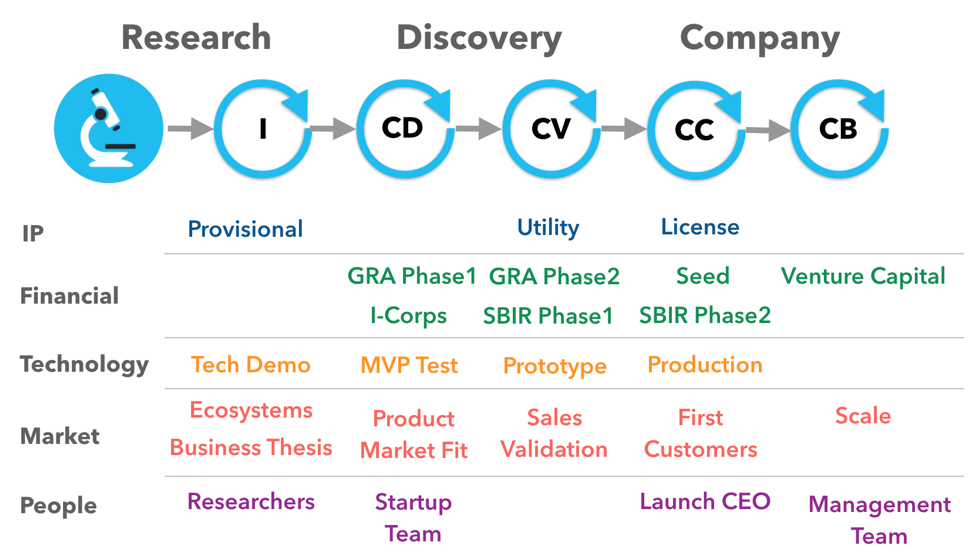The VentureLab process begins when we learn about innovative Georgia Tech research with commercial potential, often while academic papers are being prepared or shortly after they’re published. We meet with the researchers to learn more about the work, speculate about potential applications, and consider options for funding of activities to reduce early stage market and technical risk. We can then establish a startup — but that doesn’t mean getting a logo designed and running off to the lawyer to incorporate.
Steve Blank, entrepreneur, author, and cofounder of the NSF I-Corps, defines a startup as a temporary organization searching for a repeatable and scalable business model. Until customer needs are known and a compelling business model can be found, there is no business. He also defines four stages that all new companies go through, from research to company launch and growth. We at VentureLab have added a fifth stage, Ideation, at the front end of the process.

Disclosure
An important step in ensuring the protection of Georgia Tech’s intellectual property — and the viability of a startup based on that IP — is careful conformance to the invention disclosure process. Before an innovation is revealed to the public through a paper, poster, or presentation, researchers need to complete the web-based Invention Disclosure process. With this step completed, the Georgia Tech Research Corporation, the legal owner of all university-developed IP, can begin the process of evaluating the invention and preparing the appropriate patent filings. It’s important to note that without following this process, inventors and Georgia Tech may lose the opportunity to patent their innovations.
Ideation
Technology innovations are often created without any specific application in mind. The Ideation stage is where we evaluate the potential use cases for a technology innovation. Where can it be used? To whom do we believe great value can be delivered? We’ll evaluate multiple potential use cases with the goal of finding one strong business thesis: a statement defining what our product is, who our customer is, and why they will buy.
During this phase, VentureLab will also help establish a startup team. These teams usually include a faculty member, one or more students, a VentureLab principal, and mentors and advisors from the business world, although this composition can vary based on circumstances and availability. With our team in place, we move into the next phase.
Customer Discovery
 Customer Discovery is the process of getting out of the building, talking to customers and users and learning about customers’ problems and needs. We’ll start with our general business thesis, and then make reasonable hypotheses about what must be true such that the thesis is true. Then we’ll test these hypotheses through a series of interviews with potential customers. As evidence is gathered, we continuously update our hypotheses, business thesis, and business model canvas, shown at right. After 100 interviews, we have either a great understanding of our customer and a compelling business model, or we go back to the whiteboard and start making changes.
Customer Discovery is the process of getting out of the building, talking to customers and users and learning about customers’ problems and needs. We’ll start with our general business thesis, and then make reasonable hypotheses about what must be true such that the thesis is true. Then we’ll test these hypotheses through a series of interviews with potential customers. As evidence is gathered, we continuously update our hypotheses, business thesis, and business model canvas, shown at right. After 100 interviews, we have either a great understanding of our customer and a compelling business model, or we go back to the whiteboard and start making changes.
A key element of the CD process is that we don’t talk about the innovation or technology on the front end of the interview. We’re there to learn, not to “pitch”. Selling or trying to persuade the interviewee of the value of the technology tends to bias the discussion. Rather, we use a style of open, adaptive inquiry to discover where the true pains are in the market, and observe if our hypotheses match up with actual customer experience. Naturally, on the back-end of an interview, it is natural to say: “What we have is early…not a product yet, but here’s what we’re working on.” Useful feedback will arise, but without biasing earlier opinions and insights.
Customer Validation
Customer Validation (CV) is when we build our first functional prototypes and test our sales process. In CD, we learn about our customers’ needs. In CV, we prove they will be willing to buy our product. You do this by testing your Value Proposition in front of potential early-adopter or ‘earlyvangelist’ customers. If we cannot prove a sales process, we must pivot our business model and go back to the Ideation stage.
Customer Creation
Once we have a deep understanding of our customers and a proven sales process, we can form a company and raise outside capital. During the Customer Creation (CC) phase, we will attempt to get an early adopter to actually pay for our product or service. Once this has been done, not once but several times, will we have a shot at raising money. If we can on-board several customers (3-5), we will have proven your business model is repeatable. We have yet to prove our business is scaleable!
Customer Creation is usually the stage where we legally form a company and raise seed capital. The founders often start working on the business full time.
Company Building
Company Building (CB) is the process of scaling up our business. This is the stage where we might move into an incubator such as ATDC as well as raise your first round of venture capital. You will use this stage to build out a complete management team and start focusing on execution of a now proven business model.
